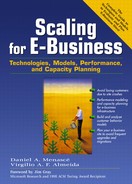2.7. Metrics Derived from the CBMG
We explore here how the CBMG can help in providing quantitative insight into how customers interact with an e-commerce site. For example, we would like to be able to answer the following types of questions with the help of the CBMG.
How many times on average is each e-business function (e.g., Search, Browse, Select, Add) invoked per visit to the e-commerce site?
On average, how often customers buy something each time they visit the e-commerce site?
What is the average number of e-commerce function executions requested by a customer during his/her visit to the store?
Answers to these and other questions can be obtained through the solution of a set of linear equations derived from the CBMG. We defer to Chapter 11 the formal treatment and discussion of these equations. In this chapter, we provide a more informal and intuitive view of these equations. For this purpose, in the numerical examples that follow, we use the MS Excel workbook, called CBMG.XLS, that can be downloaded from the Web site associated with the book (see Preface) by following the link to Chapter 2.
Example 2.1
Consider the CBMG of Fig. 2.4. What is the average number of visits to each state of the CBMG?
To answer this question, we used the MS Excel workbook CBMG.XLS. The worksheet TransitionProbabilities of this workbook has the transition matrix P shown in Table 2.1. The worksheet Visit Ratios shows, in blue in line 7, the average number of times that each state of the CBMG is visited per visit to the site. Table 2.3 shows the results displayed in the worksheet.
Instructions in the worksheet indicate how to obtain the visit ratios in Table 2.3. These numbers give us some interesting insight into the behavior of the customers who visit our virtual bookstore as described in the examples that follow.
| State | Visit Ratio |
|---|---|
| Entry | 1.000 |
| Home | 1.862 |
| Browse | 2.303 |
| Search | 2.193 |
| Login | 0.274 |
| Pay | 0.058 |
| Register | 0.196 |
| Add to Cart | 0.193 |
| Select | 0.919 |
| Exit | 1.000 |
Example 2.2
Consider again the CBMG of Fig. 2.4 and the solution to the average number of visits per state of the CBMG given in Ex. 2.1. Suppose the site receives 100,000 visitors per day. What is the fraction of visitors that end up buying from the virtual bookstore? What is the average number of sale transactions performed per day? What percentage of customers leave the site after having added at least one item to their shopping cart?
Since the average number of visits to the Pay state per visit to the site is 0.058. 5.8% of the visitors end up buying from the bookstore. Since 100,000 customers visit the store per day, the site has to be able to process 5,800 sale transactions per day. However, 19.3% (i.e., 0.193) of the visitors add at least an item to their shopping carts, but only 5.8% buy. So, 13.5% (=19.3% - 5.8%) leave the site without buying while having at least an item in their shopping carts. This could be caused by a high response time at the site, which causes customers to become frustrated with the site and move their business to other e-stores. The survey "GVU's WWW User Surveys" showed that around 19% of the people surveyed attribute bad experiences they had with e-business sites to bad performance [2]. Customers who have items in their shopping carts and leave the site represent a potential loss in revenue to the e-business. This type of situation should be avoided.
An important metric for e-business sites is the buy to visit ratio (BV), defined as the average number of sale transactions per visit to the site. As we can see from Ex. 2.2, this ratio is simply given by the average number of visits to the Pay state.
Example 2.3
Consider again the CBMG of Fig. 2.4. What is the average number of requests submitted to the e-commerce server per session?
That is, what is the average session length? This can be easily obtained by adding the average number of visits to the states Home, Browse, Search, Login, Pay, Register. Add to Cart, and Select. So, the average session length is equal to 1.862+2.303+2.193+0.274+0.058+0.196+0.193+0.919 = 7.998
In general, the average session length is given by the sum of the visit ratios for all states of the CBMG, except the Entry and Exit states.
Example 2.4
Consider again the CBMG of Fig. 2.4. What is the new buy to visit ratio if the following changes are made to the transition probabilities: pSelect,Browse = 0.4, pSelect,AddtoCart = 0.1, pSelect,Search = 0.4? These changes indicate a smaller probability that customers will add an item to their shopping carts after they have selected it.
To answer this question, we use again the workbook CBMG.XLS, make the proper changes in the probability values in the worksheet Transition-Probabilities, and use the solver again to obtain the new values of the visit ratios. The new value of the buy to visit ratio is the new value of the average number of visits to the Pay state, which is 0.030. In other words, now only 3.0% of the customers who visit the site buy as opposed to 5.8% in the previous ease.
